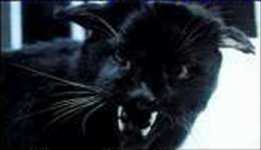
Report from Jon Downes
Large Kellas Cats in Aberdeenshire
Report by Tom Anderson for Animals & Men, published by Jonathan Downes
 July 1995. Strathdon, Aberdeenshire.
July 1995. Strathdon, Aberdeenshire.
Mr and Mrs Jeffrey, accompanied by their grandchildren, were driving up a rutted farm track in Strathdon, Aberdeenshire at a sedate five miles an hour. Six metres in front of them, a large black cat crossed the track. They stopped. It was five feet from muzzle to tail, (which was two feet long), and covered in 1,5/2" long fur. Estimated height was about two foot plus. After crossing the track it drew alongside the car and surveyed the occupants before moving on. The legs were described as "stuck on the corners", and too slender for the torso. So sure was the witness that she had encountered a laboratory escapee that she contacted the university. They vehemently denied any 'gene juggling', on cats at least; we know of trials involving goats and Llamas.
Relatives of the witnesses saw an identical (but tawny) cat carrying a rabbit on a shingle beach at Slains, just north of Aberdeen. Friends of Mrs Jaffrey, who own the land at Strathdon, have seen the melanistic cat cross a field of cows with calves at foot. The cows total lack of interest in its presence shows at least one generation of familiarity. Although definitely feline, the nearest comparison this (and other witnesses) can make is 'lurcher-like'. The same animal, in two colours, has been seen on the north-east coast, Highlands, and Tayside in Scotland. The distances confirm three colonies at least, of an animal more gracile then the usual puma type. You will not be surprised to learn that Mrs Jeffrey 'usually kept a camera in the glove box, but for some reason it wasn't there when she needed it'. I would add that the above is an 'expert witness' and has familiarity with foxes and wildcats that would shame some naturalists.
A second letter by Tom Anderson
(As a postscript to last months interview with Mrs. Jaffrey and her very detailed description of a cat in Strathdon, it would seem obvious what her and her relatives had seen on both occasions. Her description could only describe one animal (apart from the five foot long, two foot high part). The next day I sent her a set of photos of what I thought she had seen along with some background to fill in the details. Twenty four hours later she telephoned to say this is exactly what she had seen. They were, of course, photographs of the Kellas Cat, and not being set a scale for comparison, she had no way of knowing that they showed a cat at least fifty per cent smaller then hers. We now have three 'King Kellas' sightings in a triangle measuring sixty miles at each side. I don't know about you but I can't see a wildcat being the progenitor of this.
Yours confusedly, Tom Anderson, Scottish correspondent for Animals & Men
 |
 |
 |
 |
| Return to index | Return to Scottish Big Cats | Return to Aberdeenshire | Return to date unknown |